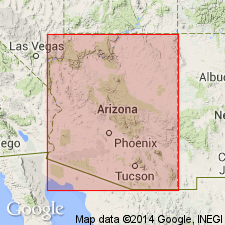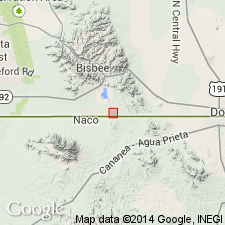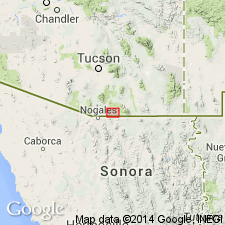
- Usage in publication:
-
- Patagonia group
- Modifications:
-
- Original reference
- AAPG geologic province:
-
- Basin-and-Range province
Summary:
Pg. 297 (table). Patagonia group. Named on table. Contains Molly Gibson formation (new). Older than Santa Cruz group (new); younger than Bisbee group. Age is Early Cretaceous.
Source: US geologic names lexicon (USGS Bull. 1200, p. 2940).

- Usage in publication:
-
- Patagonia group
- Modifications:
-
- Revised
- Biostratigraphic dating
- AAPG geologic province:
-
- Basin-and-Range province
Summary:
Pg. 30-31, 36 (table 6), 53. Patagonia group. Sequence composed mainly of dark shales sporadically interbedded with arenaceous strata and volcanics and, in the upper third, with bedded arenaceous limestones (Molly Gibson formation). Total thickness about 5,850 feet. Age is Early Cretaceous (Albian); STOLICZKAIA DISPAR standard ammonite zone. Geographic area given.
Notable exposures in Patagonia Mountains, southeastern AZ.
Source: Publication; US geologic names lexicon (USGS Bull. 1200, p. 2940).

- Usage in publication:
-
- Patagonia Group*†
- Modifications:
-
- Abandoned
Summary:
Not used in Patagonia Mountains in the Basin-and-Range province because poorly described and vaguely identified.
Source: GNU records (USGS DDS-6; Denver GNULEX).
For more information, please contact Nancy Stamm, Geologic Names Committee Secretary.
Asterisk (*) indicates published by U.S. Geological Survey authors.
"No current usage" (†) implies that a name has been abandoned or has fallen into disuse. Former usage and, if known, replacement name given in parentheses ( ).
Slash (/) indicates name conflicts with nomenclatural guidelines (CSN, 1933; ACSN, 1961, 1970; NACSN, 1983, 2005, 2021). May be explained within brackets ([ ]).

